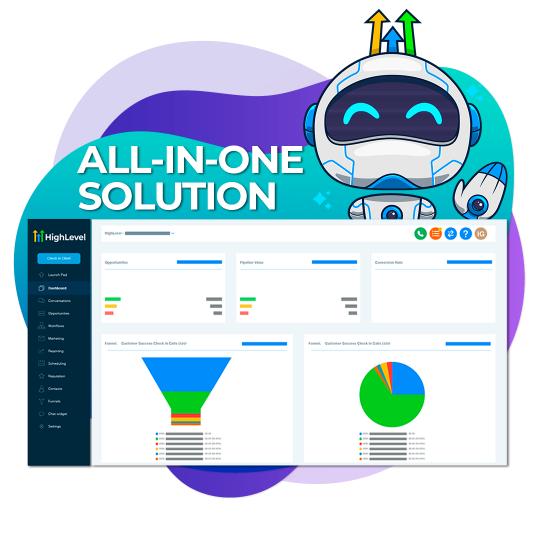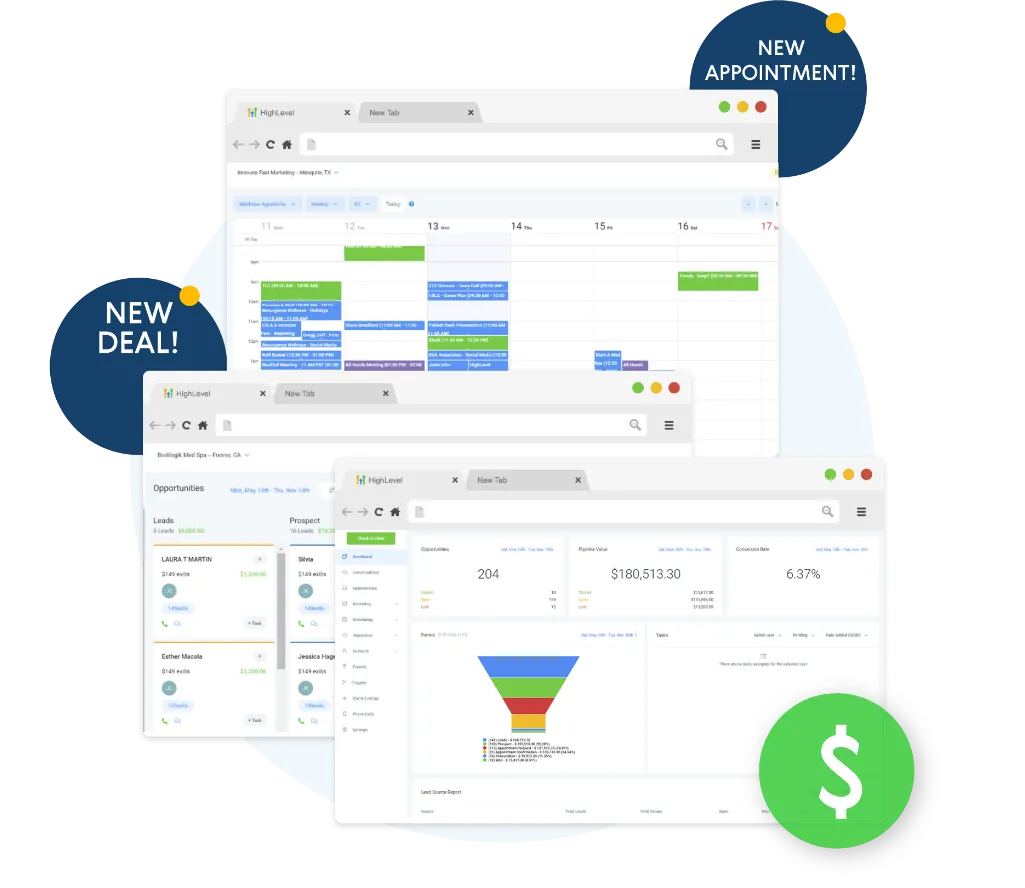Let's turn customer information into stories that matter. Think of it like making a friend. We learn about them, remember what they like, and share things they care about. When we look at how customers shop and what they enjoy, we can tell better stories. Pictures and maps help us see where customers need help or feel happy. Then, we can send friendly notes at just the right time. This makes customers feel special and heard. The more we share stories they care about, the more they trust us. When we mix good data with warm, friendly stories, customers stay longer and buy more. It's like having a nice chat with someone who really gets you.
Feeling overwhelmed by missed leads and disorganized workflows?
Discover the award-winning platform that automates follow-ups, tracks every lead, and keeps your business running smoothly—all in one place. Thousands of businesses are already transforming their sales and marketing with this trusted solution. Don’t miss out—start your 14-day free trial today and click now to uncover exclusive, limited-time special offers!
Understanding Data-Driven Customer Stories

Raw data can tell us stories about our customers when we look at it carefully.
Think of it like putting puzzle pieces together – we gather information from different places to see the full picture of who our customers are and what they like.
By looking at simple patterns, we can learn what customers might do next.
It's like knowing your friend loves chocolate ice cream, so you can guess what they'll order at the ice cream shop.
We test different ways to talk to customers to see what works best.
This helps us send messages they care about.
When we know what customers want, we can give them better service.
The more we learn about our customers, the better we can be at making them happy.
It's like having a good talk with a friend – the more you listen, the better you understand them.
Building Customer Personas Through CRM
We look at how real customers act and what they like to help us know them better. Think of it like making a picture of your typical customer.
We watch what they buy, how they talk to us, and what makes them happy. This helps us group similar customers together. When we understand our customers as real people, we can give them what they need.
We use simple computer tools to keep track of all this info. This way, we can be better friends to our customers and help them more.
Data-Driven Profile Creation
Customer profiles help us know our customers better. We look at how people use our website, what they share on social media, and how they read emails. This tells us what they like and how they shop.
We use special tools to sort customers into groups. These tools help us see patterns in how people act. We also talk to customers to learn more about them. This helps us create better profiles.
When we collect all this info, we make sure it tells us a clear story about our customers. We need enough good data to paint the right picture.
Behavioral Pattern Recognition
We watch how people act to understand them better. This helps us serve them well.
We look at what people do on our website and in our stores. We see when they buy things and what they like to read. We keep their info safe and private.
We learn about our customers by putting them in groups. Some like sports, others like music. Knowing what they love helps us make them happy.
We show what we learn with pictures and stories. This makes it easy for our team to understand.
When we know our customers better, we can help them more. This makes our business grow.
Ready to simplify your business operations?
Streamline your workflows and boost productivity with a CRM designed to save you time and effort. From tracking leads to automating follow-ups, this platform does it all. Discover what’s possible—learn more about how it works and see why so many businesses rely on it every day.
From Numbers to Narratives

We turn bare numbers into stories about real people.
We look at how customers act and what they like. Using simple charts and pictures, we show these stories in a way everyone can understand.
When we share these stories with our teams, they see what customers need. This helps us make better choices for our business and serve people better.
Data Brings Stories Alive
Data tells stories about people like you and me. But first, we need good data. This means getting the right numbers in a clean way.
When we look at the data, we can see what happened in the past. We can also guess what might happen next. The best part is finding new things that make us feel something. Pictures and charts help us see the story better.
We must think about real people when we tell these stories. What makes them happy? What do they want? This helps others care about what the numbers mean.
In the end, we need to show what to do next to make things better.
Visualizing Complex Information Flows
Data pictures help us see hard things in simple ways. When you share data with your team, pick the right type of picture. Use bars to show sales numbers side by side. Use lines to show how things change over time. Use pie slices to show parts of your market – but keep it to five slices.
Make your pictures easy to read. Use no more than five colors. Put clear words on everything. Get rid of extra stuff that doesn't help tell the story. Add notes to help others understand what the data means.
Your pictures can come alive on screens that update by themselves. This helps teams see what customers are doing right now.
When you show data, don't just show numbers. Tell a clear story that helps people make good choices.
Building Meaningful Brand Connections
Stories help us make sense of numbers better than charts alone. When we use what we know about our customers, we can tell stories they care about.
Good stories come from real people who use our products. We look at how customers behave and what they like. Then we can tell stories that feel special to each person. This helps people see how our brand fits in their life.
When we share what we believe in through our stories, it touches people's hearts. We talk about things that matter to them every day. This makes people remember us and trust us more.
Still struggling to keep your business organized?
Take the guesswork out of managing leads and follow-ups with a platform trusted by thousands of businesses. Say goodbye to missed opportunities and hello to a seamless sales process. Act now—try it free for 14 days and discover how easy it is to stay on top of your workflow. Don’t wait—exclusive offers won’t last long!
Crafting Compelling Brand Stories
Stories help brands connect with people. Good brand stories mix real people's experiences with careful planning. When we turn numbers and facts into stories, people listen better. Your stories should help people and match what they care about.
Simple Ways to Tell Better Brand Stories:
- Ask customers what they think to build trust
- Look at data to know what people want
- Tell the same story on all platforms
- Make stories fun so people join in
- Team up with others to reach more people
This way of telling stories helps brands grow and makes people remember them. When you share real, honest stories, people feel closer to your brand.
| What To Do | Why | What Happens |
|---|---|---|
| Ask Customers | Be Real | More Trust |
| Study Facts | Learn More | Better Messages |
| Stay the Same | Keep Clear | Strong Brand |
| Make it Fun | Get People In | Good Memories |
| Work Together | Grow Big | New Friends |
CRM Automation in Storytelling

We tell better stories to customers when we make our CRM tools work smarter.
We send the right message at the right time to each person. When people shop or click, we share stories they care about.
This helps us talk to many people in a way that feels special to them. Like friends sharing stories, we match what we say to what customers do.
This makes our stories feel more real and fun.
Workflow Messaging Integration
Messages help us talk better with customers. Think of it like a friendly chat that happens at just the right time. Simple tools make it easy to send the right message to each person.
When someone does something, like buying from you, the tools know what to do next. They send a nice note or helpful info right away. It's like having a helper who knows just what to say and when to say it.
These tools watch how people react to your messages. If they like something, you can send more like that. If they don't, you can try something new. You can send welcome notes to new customers or special messages to long-time friends.
Dynamic Content Timing
When to Share Your Stories
Telling stories to your readers works best when you do it at the right time. Think of it like talking to a friend – you want to pick good moments to share.
- Watch when people read your stories most.
- Share local stories that matter to people near you.
- Look at how many people read your stories and pick better times.
- Show different parts of your story to people based on what they like.
This way helps you tell better stories that people want to read. Like a good friend, you learn when to talk and what to say.
Your readers get stories they care about, right when they want them.
Struggling to keep up with your growing business?
Simplify your processes and stay ahead with a CRM that adapts to your needs. Manage leads, automate tasks, and focus on what matters most—growing your business. Take the first step—explore the features today and see how it can transform the way you work.
Personalization Through Data Analysis
We make our messages feel more personal by looking at what our customers like and do. It helps us talk to them in a way that feels just right.
We put people into groups based on things like their age, what they buy, and what they enjoy. This lets us send the perfect message to each person.
Our computer can send special notes on birthdays or share deals that each person will love. We keep track of how well this works by counting how many people respond.
When we do this right, our customers feel special and buy more from us.
Visual Storytelling With CRM

We tell customer stories with easy-to-see pictures and charts. When we show data this way, teams can make better choices right away. They don't have to look at boring numbers.
To make our stories clear:
- Pick 5-6 colors to show what matters most
- Draw maps to see where customers live and shop
- Group facts by topic, not just by time
- Add clickable parts so people can dig deeper
These simple tools help us see patterns in how customers act. They turn big piles of info into a story anyone can follow.
Customer Journey Mapping
Let's see how customers move through their time with your brand. Think of it like drawing a map of their journey.
First, they learn about you. Then they look at what you offer. Finally, they buy something and stay in touch.
Drawing this map helps you spot where people get stuck or feel unhappy. You can see what they like and don't like. This helps you make things better for them.
When your whole team sees this map, everyone knows how to help customers better. You learn new things about what customers really do, not what you think they do.
The more you watch and learn from these journeys, the better you can make each customer feel special and happy with your brand.
Measuring Story Impact

Stories Matter: How to Know if People Like Them
When you tell stories to your customers, you want to know if they work. You need to look at more than just numbers. You need to see if your stories help your business grow.
Here's what to look for:
- See if people know about you
- Count how many people talk about you online
- Check if people search for you
- Look at how many visit your website
- See if people stick around
- Watch how long customers stay with you
- Check if they keep buying from you
- Find out how people feel
- Look at what they say about you
- Ask them what they think
- See if stories lead to sales
- Count how many people buy after hearing your story
Use simple tools to watch these things. Look at your website data. Check what people say on social media. Listen to your customers.
This helps you make better stories that work for your business.
Emotional Connection Through Data
We care about how people feel when they talk to businesses. Think of it like reading a friend's face to know if they are happy or sad.
Smart computer tools help us see what customers feel. When we know how they feel, we can help them better.
Here's what we look at:
- How people feel right now
- When people need our help most
- What each person likes best
- What people might want next
This helps us tell better stories about what our customers need. When we know what makes them happy or sad, we can fix problems fast. We can send messages they care about.
The best part? Happy customers stay with us longer. They tell their friends about us too. It's like making a new friend who trusts you to help them.
Simple Table:
What We Watch | What We Do
————–|————
Feelings | Check how people feel
Key Times | Help when needed most
Personal Likes | Send the right message
Actions | Guess what they need next
CRM Stories That Convert

Let's Talk About Customer Stories That Work
When we learn how customers feel, we can tell better stories to help them. Good stories need both facts and feelings. Think of it like sharing a friend's success story – it should be real and helpful.
To make your stories work well:
- Show real problems that customers faced and how they fixed them.
- Tell stories about people just like your readers.
- Share numbers that prove your help worked.
- Tell readers exactly what to do next.
Ask your customers what they think and use their words. This helps make better stories. When you tell stories this way, customers see you as a friend who wants to help them win.
Keep your stories simple and true. Talk like you'd to a friend. This makes people trust you more and want to work with you.
Future of CRM Storytelling
CRM storytelling is changing to be more human and friendly. Instead of just showing numbers, it now tells stories about customers in a way that feels like a real talk.
New tools help make this happen:
| What's New | How It Helps You |
|---|---|
| Smart AI | Makes stories just for each customer |
| Smart Bots | Helps build better stories |
| AI Helpers | Shares stories on many platforms |
| Special CRM Tools | Makes stories fit your field |
These tools look at what customers do and like. They help tell better stories about them. They can even guess what customers might want next.
New tech also picks up info from phones, apps, and social media. This helps paint a full picture of each customer. The more we know, the better stories we can tell. Good stories make customers feel heard and want to stay with your business.
Conclusion
Think of yourself as a story finder. Like someone who finds old treasures in the ground, you look for special stories in your customer data. Each bit of info is like a clue that shows how your customers shop and what they like. Most people want stores to treat them in a special way that fits them. When you turn your data into simple stories, you help give customers what they want.








